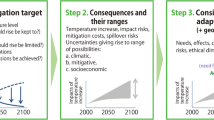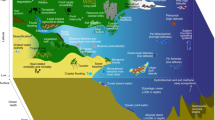Abstract
The climate change problem must be thought of in terms of risk, not certainty. There are many well-established elements of the problem that carry considerable confidence whereas some aspects are speculative. Therefore, the climate problem emerges not simply as a normal science research issue, but as a risk management policy debate as well. Descriptive science entails using empirical and theoretical methods to quantify the two factors that go into risk assessment: “What can happen?” and “What are the odds?” (Probability x Consequences).
Policymakers should, in turn, take that information and use it to make value judgments about what is safe, what is dangerous, what is fair. To make these judgments, policymakers need to know the probabilities that experts assign to various possible outcomes in order to make risk management decisions to hedge against unsafe, dangerous and unfair outcomes. The climate debate needs to be reframed away from absolute costs—or benefits—into relative delay times to achieve specific caps or to avoid crossing specific agreed “dangerous” climate change thresholds. Even in most optimistic scenarios, CO2 will stabilize at a much higher concentration than it has reached today, and temperature will rise accordingly. It will take even longer for sea level rise from thermal expansion and the melting of polar ice to occur, but what is most problematic is that how we handle our emissions now and in the next five decades preconditions the sustainability of the next millennium.
Similar content being viewed by others
References
Funtowicz, S.O. & Ravetz, J.R. (1993) Three types of risk assessment and the emergence of post-normal science, in Krimsky, S. & Golden, D. eds. Social Theories of Risk. Greenwood, Westport, CT: 251–273.
Kuhn, T. (1962) The Structure of Scientific Revolutions. University of Chicago Press, Chicago.
United Nations Framework Convention on Climate Change (1992) United Nations Framework Convention on Climate Change: Convention Text. UNFCCC, Bonn. Available at: http://unfccc.int/essential_background/convention/background/items/2853.php
Goulder, L.H. & Schneider, S.H. (1999) Induced technological change and the attractiveness of CO2 abatement policies. Resource and Energy Economics 21: 211–252.
Kaya, Y. (1990) Impact of carbon dioxide emission control on GNP growth: Interpretation of proposed scenarios. Paper presented to the IPCC Energy and Industry Subgroup, Response Strategies Working Group, Paris, (mimeo).
Yang, C. & Schneider, S.H. (1998) Global carbon dioxide emissions scenarios: Sensitivity to social and technological factors in three regions. Mitigation and Adaptation Strategies for Global Change 2: 373–404.
Ehrlich, P.R. & Holdren, J.P. (1971) Impact of population growth. Science 171: 1212–1217.
IPCC (2000) Emissions Scenario: A Special Report of Working Group III of the Intergovernmental Panel on Climate Change. Nakicenovic, N. & Swart, R. eds. Cambridge University Press, Cambridge, UK.
IPCC (2001) Synthesis Report 2001—Contribution of Working Groups I, II, and III to the Third Assessment Report of the Intergovernmental Panel on Climate Change. Watson, R.T. & the Core Writing Team eds. Cambridge University Press, Cambridge, UK.
Schneider, S.H. (2001) What is “dangerous” climate change? Nature 411: 17–19.
Schneider, S.H. & Kuntz-Duriseti, K. (2002) Uncertainty and climate change policy, Chapter 2 in Schneider, S.H., Rosencranz, A. & Niles, J.O. eds. Climate Change Policy: A Survey. Island Press, Washington D.C.: 53–88.
Morgan, M.G. & Keith, D.W. (1995) Subjective judgments by climate experts. Environmental Science and Technology 29: A468-A476.
Jones, R.N. (2000) Managing uncertainties in climate change projections: Issues for impact assessment. Climatic Change 45(3–4): 403–419.
Forest, C.E., Stone, P.H., Sokolov, A.P., Allen, M.R. & Webster, M.D. (2002) Quantifying uncertainties in climate system properties with the use of recent climate observations. Science 295(5552): 113–117.
Andronova, N.G. & Schlesinger, M.E. (2001) Objective estimation of the probability density function for climate sensitivity. Journal of Geophysical Research 106: 22605–22612.
Schneider, S.H. (2003) Abrupt non-linear climate change, irreversibility and surprise, in Estimating the Benefits of Climate Policies, Washington, D.C.: OECD. Available online at: http://www.oecd.org/dataoecd/7/14/2483223.pdf
Schneider, S.H. & Lane, J. (2006) An overview of dangerous climate change, in Schellnhuber, H. J., Cramer, W., Nakicenovic, N., Wigley, T. and Yohe, G eds. Avoiding Dangerous Climate Change. Cambridge University Press, Cambridge, U.K.
Schneider, S.H. & Mastrandrea, M.D. (2005) Probabilistic assessment of “dangerous” climate change and emissions pathways. Proceedings of the National Academy of Sciences 102: 15728–15735.
Price, J.T. & Root, T.L (2002) No Orioles in Baltimore? Climate change and neotropical migrants. Bird Conservation 17: 12.
Thompson, L. Map of total area of ice on Kilimanjaro (1912, 1953, 1976, 1989, 2000). Published online at: http://researchnews.osu.edu/archive/kilicoresmap.htm.
Lane, J., Sagar, A. & Schneider, S. (2005) Equity in climate change. Tiempo 55: 9–14.
Schneider, S. H. & Lane, J. (2006) Dangers and thresholds in climate change and the implications for justice, in Adger, N. ed. Politics, Science, and Law in Justice Debates. MIT Press, Cambridge, MA.
Schneider, S.H., Kuntz-Duriseti, K., & Azar, C. (2000) Costing non-linearities, surprises and irreversible events. Pacific and Asian Journal of Energy 10(1): 81–106.
Azar, C. & Schneider, S.H. (2002) Are the economic costs of stabilizing the atmosphere prohibitive? Ecological Economics 42: 73–80.
Author information
Authors and Affiliations
Corresponding author
Rights and permissions
About this article
Cite this article
Schneider, S.H. Climate change: Do we know enough for policy action?. SCI ENG ETHICS 12, 607–636 (2006). https://doi.org/10.1007/s11948-006-0061-4
Received:
Revised:
Accepted:
Issue Date:
DOI: https://doi.org/10.1007/s11948-006-0061-4




